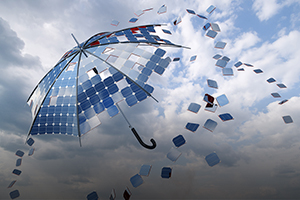Rain Power
 While solar cells are on the rise, the fact that they can’t produce energy while it’s raining is a big drawback in many areas that could benefit from a clean, renewable energy source. But a recently published article out of China may change all that with a new approach that allows solar cells to generate electricity from rainwater as well as sunshine.
While solar cells are on the rise, the fact that they can’t produce energy while it’s raining is a big drawback in many areas that could benefit from a clean, renewable energy source. But a recently published article out of China may change all that with a new approach that allows solar cells to generate electricity from rainwater as well as sunshine.
The researchers coated a solar cell with graphene – a two-dimensional form of carbon in which the atoms are arranged like a honeycomb. Graphene is rich in electrons that can move freely across its surface, enabling it to conduct electricity when bound with positively charged ions. Coincidentally, rainwater is not pure, but contains compounds like calcium, sodium and ammonium, which become ions when they are dissolved in solution. As a result, when they sit on the graphene layer, they create a “pseudo-capacitor” which captures an unbalanced charge (voltage) that can be converted to electricity.
Although the new cell is only about 6.5 percent efficient, and the voltages generated by the raindrops are only in the microvolt range, the concept is a sound one for making solar a more versatile source of power.
For information: Ocean University of China,5 Yushan Road, Chinan, Qingdao, Shandong, China; phone: +86-532-8203-2666; Web site: http://eweb.ouc.edu.cn/